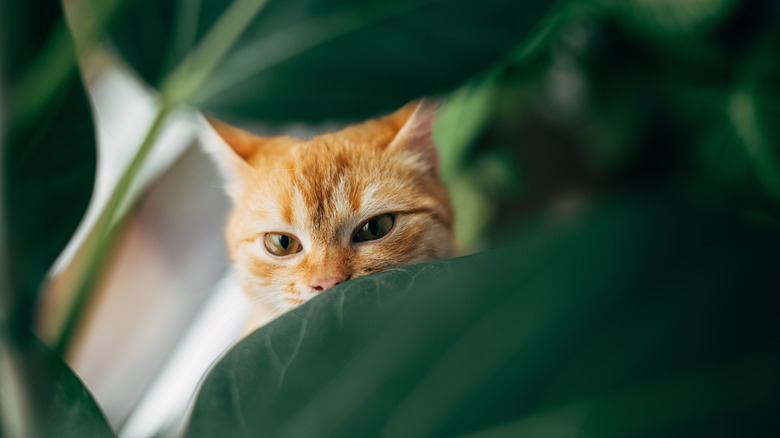The Cat-Proofing Plant Hack That Only Requires A Piece Of Fabric
Of the approximately 70% of American households that reported having pets in a 2022 national study, there were 45 million cat-owning families. Taking care of pets has well-researched mental and physical health benefits, and they can be useful social and emotional support for older individuals, but cats in particular are seen as great companions for those with depression and anxiety. However, if you are an already anxious cat owner, one key source of added anxiety might be that you want to keep them out of your houseplants — both for the sake of the plant, and for their own health. Luckily, there is an easy hack that lets you cat-proof your potted friends with a DIY cover that requires little more than some old elastic clothing and a pair of scissors.
There are plenty of plant-protecting solutions, such as mulch rings you can find on Amazon that are designed to be natural fiber covers, retaining moisture as they guard the soil. But there's no need to spend that extra money or wait for delivery times if you've got a worn-down pair of leggings or pantyhose that you've already been meaning to recycle. Just use the stretchy fabric as a cover that goes around your planter, blocking the soil from your cat. Now, your cat won't be able to crawl into the soil bed, and you'll have plenty more pantyhose material to repurpose throughout your garden.
How to cat-proof your houseplants with stretchy fabric
Going with a DIY stretchy fabric cover is one cheap and easy way to guard your plants from indoor cats, and vice versa. Just cut about a foot-long stretch of fabric out of one leggings or pantyhose leg, and then you can start to run that tube up the body of your planter to cover it. The fabric should be long enough that it continues constricting the edge of the planter as you pull the rest over its opening, all the way to the plant's trunk, to ensure cats can reach the soil. For an additional simple way to cat-proof your plants, you can toss a few orange peels into the pot, too. This could act as cat repellent, both benefitting the soil as natural compost while dissuading any creatures with a strong sense of smell.
It is worth noting that cats will be cats; feline companions are known for their independence and mischievous behavior. If your cat wants to jump up and start eating the leaves of your indoor houseplants, a wrap made from old leggings or pantyhose is not going to stop it, so it is worth doing your own research into what kind of plants should not be grown if you keep any pets. However, that elastic cover should still be effective at protecting the soil, and it is an easily replicable hack should you find that fabric starting to tear after a long time being hooked around the pot. If you put in the effort to keep your pets healthy, you can also continue to reap the rewards of having animals around, such as potentially lower blood pressure.
Why is covering your plants to keep cats out so important?
If you're a new cat owner, your first instinct might be to wonder why it's so important to cat-proof your potted plants. As mentioned, both the plant and the cats themselves will benefit from a healthy separation. A cat might climb inside a plant pot to find cool soil to rest in, as well as nibble on the greenery (possibly due to a nutritional deficiency that needs correcting). This could disfigure or damage the plant. Alternatively, your cat might use the potting soil as its own makeshift litter box, displacing the soil and leaving poop behind. One could see this as a free source of fertilizer, but cat feces might carry a number of zoonotic diseases like salmonella that could affect a plant's growth — or the viability of any edible veggies within.
On the other hand, even your indoor plants' soil might have hitchhiking bugs or other bacteria that could transfer to your cat if you don't block their access with something like a makeshift fabric cover. Letting a cat nibble on the plant itself may also be as dangerous to your pet, if not more so, than for the flora itself. A wide variety of plants are toxic to cats, including common houseplants like aloe (Aloe vera), and young animals may not be trained enough to avoid their instincts toward eating. Lilies and cyclamen are also among the plants you should never grow in a house with pets.

